AuroraEurope's satellites and deep space probes: State-of-the-Art Science Spacecraft
EUROPE IN SPACE HISTORY ROCKETS SPACECRAFT ASTRONAUTS SPACE STATION ASTRONOMY EUROPE
Aurora | BepiColombo | Cassini-Huygens | Cluster | Double Star | ExoMars | Hubble | INTEGRAL
Mars Express | Mars Sample Return | Rosetta | SMART | SOHO | Solar Orbiter | Ulysses | Venus Express | XMM
| ESA Aurora Flagship Missions | ||
| PLANET | SPACECRAFT | LAUNCH |
| Mars | Mars Express with Beagle 2 lander | 2003 |
| Venus | Venus Express | 2006 |
| Mars | ExoMars | 2007± |
| Sun | Solar Orbiter | 2008± |
| Mercury | BepiColombo | 2009 |
| Mars | Mars Sample Return | 2011± |
details > Aurora Program [ESA]
details > Science Program [ESA]
details > Science Missions [ESA]
Below, in alphabetical order, are Europe's state-of-the-art science satellites and advanced deep space probes:
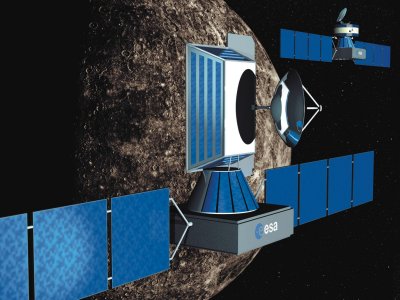 Click to enlarge ESA artist's view of Europe's BepiColombo interplanetary probe approaching the planet Mercury |
BepiColombo is a joint European Space Agency/Japanese spacecraft project planned for blast off by 2010 to explore Mercury, the planet closest to the Sun. The 3.5 year flight will be challenging because Mercury's orbit is so close to the Sun, which makes the planet difficult for a spacecraft to reach and to observe from a distance. When it arrives at Mercury, BepiColombo will endure temperatures as high as 250 degrees C while sending back new images and data from the least explored planet in the inner Solar System.
details > BepiColombo [ESA]
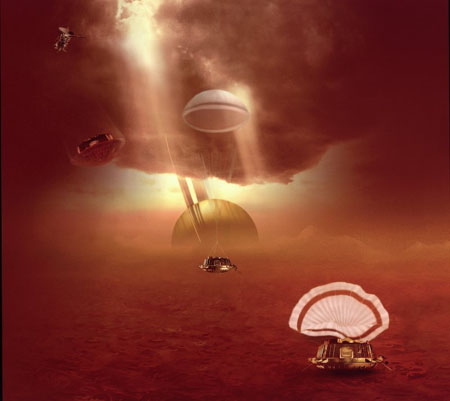 Click to enlarge ESA artist's view of Europe's Huygens lander dropping from Cassini to the surface of Titan |
Cassini and Huygens compose a joint NASA/European Space Agency deep space probe sent to explore the Saturnian system, including the planet Saturn's atmosphere, rings and magnetosphere, and some of its moons — Titan and the icy satellites. The main spacecraft is NASA's Cassini orbiter. It carries ESA's Hugyens probe to be fropped on Titan. The spacecraft is expected to arrive at Saturn on July 1, 2004, and will work there for at least four years.
details > Cassini - Huygens [ESA]
details > Cassini - Huygens [STO]
Cluster
Cluster-2 is a group of four similar spacecraft — part of the European Space Agency's and NASA's Solar-Terrestrial Science Program (STSP) to study small-scale structures in three dimensions in the Earth's plasma environment, such as those involved in the interaction between the solar wind and the magnetospheric plasma, in global magnetotail dynamics, in cross-tail currents, and in the formation and dynamics of the neutral line and of plasmoids. They were launched in 2000. Double Star, below, will join the flotilla.
details > Cluster II [ESA]
Double Star
Double Star is a joint project with China using a pair of satellites to explore the Earth's magnetosphere – the magnetic bubble that surrounds our planet. The satellites are designed, developed, launched and operated by the Chinese National Space Administration (CNSA). One will fly a polar orbit and the other over the equator. They will be synchronized with ESA's Cluster-2 group of four similar spacecraft. All six will study the same near-Earth space at the same time, looking for changes in the magnetic field and the electrified particles in different areas of the magnetosphere. The pair are to be launched by Chinese Long March 2C rockets in December 2003 and June 2004. The Cluster satellites are in elliptical polar orbits around the Earth.
details > Double Star [ESA]
 Click to enlarge ESA artist's view of Europe's ExoMars interplanetary probe descending on the planet Mars |
ExoMars, an Aurora Flagship mission, would use a Mars orbiter and a lander with rover to study the biological environment on Mars in preparation for future human explorations. The rover, planned for a flight to the Red Planet in 2009, would be able to travel a few miles using solar panels to generate electricity. The orbiter would receive data from the rover on the ground and relay it on to Earth. The 88-lb. exobiology science payload would include a lightweight drilling system, a handling device for soil samples, and instruments to search for signs of life.
details > ExoMars [ESA]
Hubble
Hubble Space Telescope is another joint NASA/European Space Agency project that was launched to a low-Earth orbit in 1990 on U.S. shuttle mission STS-31. Hubble is a long-term astronomy observatory in space. Its observes visible, infrared and ultraviolet light. Hubble revolutionized modern astronomy.
details > Hubble [ESA]
details > Hubble [STO]
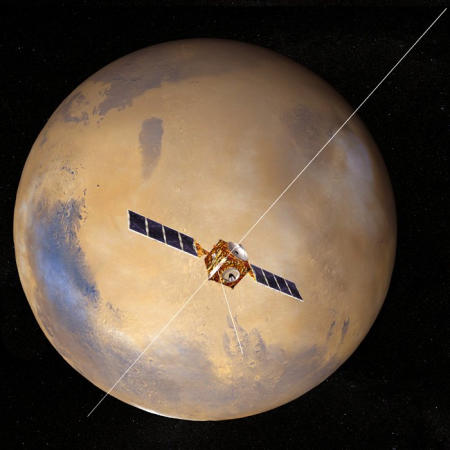 Click to enlarge ESA artist's view of Europe's Mars Express spacecraft orbiting the planet Mars |
The satellite INTEGRAL is the most sensitive gamma-ray observatory ever launched. It gathers the most energetic radiation that arrives at Earth from deep space violent events far away.
details > INTEGRAL [ESA]
Mars Express
Russia launched the Mars Express spacecraft on a Soyuz rocket from its Baikonur Cosmodrome in Kazakhstan on June 2, 2003. Mars Express reached the Red Planet on December 25, 2003, to search for sub-surface water. It dropped a small landing probe, Beagle 2, but nothing was heard from the lander on the Martian surface. The scientific instruments onboard the orbiter are carrying out a series of remote sensing experiments to shed new light on the planet's atmosphere, structure and geology.
details > Mars Express [STO]
details > Mars Express [ESA]
Mars Sample Return
Mars Sample Return, an Aurora Flagship mission to be launched in 2011, would start with an Earth-to-Mars spacecraft carrying a Mars orbiter, a lander, a launch-from-Mars module, and an Earth re-entry craft. The orbiter would fly low over Mars and release the lander. On the surface of Mars, the lander would collect about a pound of rock and soil samples to be carried up to space by the ascent vehicle. A miniature drill would be used to collect the sample of Martian soil from underneath the upper layer of soil. The ascent vehicle carrying the samples would be launched to orbit around the Red Planet where it would rendezvous with the Earth re-entry vehicle. After the Earth re-entry vehicle traveled to Earth, it and the samples would be recovered and isolated in a "curation facility" to prevent contamination. It would be necessary to avoid contamination of Mars by organisms from Earth and to avoid contamination of Earth by Martian organisms, if there are any. At the end of the trip home from Mars, the unmanned Earth re-entry vehicle would look something like a small version of the Apollo capsule used by the United States in the late 1960s. It would weigh about 110 lbs.
details > ExoMars [ESA]
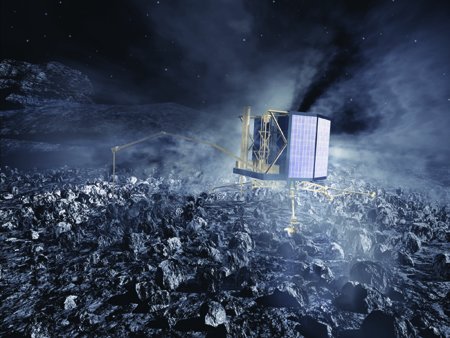 Click to enlarge ESA artist's view of Europe's Rosetta lander on the surface of a faraway comet |
Rosetta is an interplanetary spacecraft designed to rendezvous with and measure a comet. It was to have been launched from Earth in 2003-2004 on a flight to the comet 46 P/Wirtanen, arriving there about 2012. Unfortunately, that comet target had to be abandoned when the Rosetta launch was postponed after Europe's Ariane 5 rocket failures.
ESA scientists used the Hubble Space Telescope and the European Southern Observatory in Chile to find a suitable target to replace Wirtanen. They selected Comet Churyunov-Gerasimenko for a Rosetta launch on February 26, 2004, or later.
When it flies, the spacecraft also will carry the German-built Rosetta lander — the Surface Science Package — to the nucleus of the comet and drop it on the surface. Along the way, during its multi-year journey to the comet, Rosetta may pass close to one or more asteroids. The long mission duration will require extended hibernation periods for the spacecraft.
details > Rosetta [ESA]
details > Rosetta [STO]
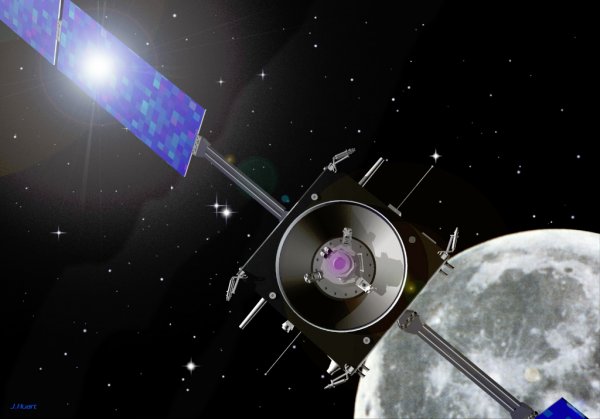 Click to enlarge ESA artist's view of Europe's SMART-1 lunar orbiter |
The Small Missions for Advanced Research in Technology (SMART-1) spacecraft is conducting Europe's first exploration of the Moon. An Ariane 5 rocket ferried the unmanned, solar-powered, SMART-1 lunar exploration probe to space on September 27, 2003, from the European Space Agency's Guiana Space Center at Kourou, French Guiana, on the northeast coast of South America. SMART-1 was released from the rocket into Earth orbit 41 minutes after launch. From there it began a 14-month journey into orbit around the Moon, using the latest solar electric propulsion technology to move from Earth orbit to an elliptical orbit around the Moon. Such a propulsion system is slow, requiring months for the journey to the Moon, but it is lightweight and inexpensive to operate. SMART-1 arrived in lunar orbit on November 15, 2004. The probe sent back to Earth its first close-up images of the Moon's cratered landscape recorded between December 29, 2004, and January 3, 2005. The SMART-1 images will be used over time to construct a map of the entire lunar surface. The 815-lb. spacecraft will do its work there for at least two years. As a testbed for new propulsion, astronomy and communication technologies, SMART-1 will use a high-resolution camera, an infrared spectrometer, and a battery of miniature instruments to:
- conduct detailed mapping of the Moon's surface, including the far side never seen from Earth.
- examine infrared light as it looks for water hidden deep in craters on the lunar surface.
- use X-rays to map the chemical composition of the lunar surface. A spectrometer will measure the amounts of key elements such as silicon, aluminum and magnesium in rocks on the lunar surface.
- gather chemical data to test a theory that the Moon was created when a giant asteroid struck Earth during the early days of our Solar System 4.5 billion years ago. That theory would be supported by a greater presence of lighter elements such as magnesium or aluminium vs. a lesser presence of heavy elements such as iron.
- test the establishment of a laser beam link with Earth for communications.
details > SMART-1 [STO]
details > SMART-1 [ESA]
details > SMART-1 [ESA]
details > SMART-1 [STO]
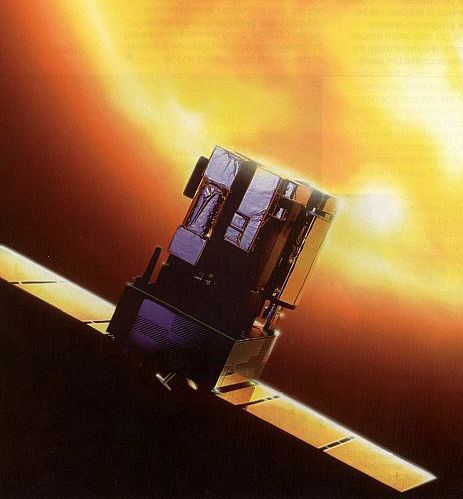 Click to enlarge NASA artist impression of SOHO at the Sun |
The Solar and Heliospheric Observatory (SOHO) is another joint NASA/European Space Agency project — this time to study the Sun. The satellite observatory is viewing and investigating the Sun from its deep core, through its outer atmosphere — the corona — and the domain of the solar wind, out to a distance ten times beyond Earth's orbit.
details > SOHO [ESA]
details > SOHO [NASA]
details > SOHO [STO]
details > SOHO [STO]
details > SOHO [STO]
Solar Orbiter
Solar Orbiter will fly closer to the Sun than any past probe, resisting great heat and violent outbursts of atomic particles from explosions in the solar atmosphere to point its telescopes at the Sun from just one-fifth of Earth's distance from the Sun. At that distance, sunlight will be twenty-five times more intense than what we see on Earth. Pictures will include details just 60 miles across. The probe will use solar-electric propulsion tested earlier by the SMART-1 Moon probe and instrument heat-proofing developed for BepiColombo. Engineers will design the equipment so heat won't damage optical coatings or melt glue that attaches solar cells to solar panels. Over seven years, Solar Orbiter repeatedly will swing by Venus to use that planet's gravity to change its orbit around the Sun. At times, Solar Orbiter will seem to hover over spots on tbe surface of the Sun for days. Solar Orbiter will photograph the Sun, like Europe's successful Solar and Heliospheric Observatory (SOHO), and sample the environment of the Sun's heliosphere from above the ecliptic plane, like Europe's Ulysses spacecraft.
details > Solar Orbiter [ESA]
Ulysses
Ulysses is a joint European Space Agency/NASA project — exploring the previously unknown region of space above the poles of the Sun. It was ferried to space by U.S. shuttle Discovery in 1990. As Ulysses flew by Jupiter in 1992, a gravity assist manuever placed the spacecraft in a unique solar polar orbit, allowing it to fly over the south pole of the Sun in 1994 and over the north pole in 1995. Ulysses then completed a second orbit of the Sun.
details > Ulysses [ESA]
details > Ulysses [STO]
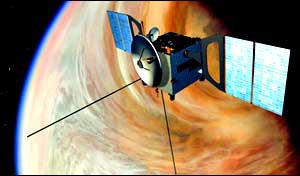 Click to enlarge ESA artist impression of Europe's Venus Express orbiting the planet Venus |
The European Space Agency in 2005 will send Venus Express to probe the second panet out from the Sun. The spacecraft will explore the Venutian atmosphere where scientists want to understand the origin of violent winds which blow around the planet. Astronomers also want to understand why Earth and Venus developed in radically different ways. Venus is similar in diameter and mass to Earth, yet that planet has evolved differently, with a surface temperature hotter than a kitchen oven — in fact, hot enough to melt lead. Venus is enveloped by a thick atmosphere that is a choking mixture of noxious gases. To study that atmosphere, and make the first radar soundings below the planet's surface, Venus Express will use the same basic spacecraft design as ESA's Mars Express probe and will carry the kind of instruments originally developed for Mars Express and Rosetta. Russia will launch Venus Express on a Soyuz rocket from its Baikonur Cosmodrome in Kazakhstan in October or November 2005. The Russians won the assignment by successfully blasting the Mars Express spacecraft toward the Red Planet on a Soyuz rocket from Baikonur on June 2, 2003.
details > Venus Express [ESA]
details > Venus [BBCi]
details > Solar System [BBC]
details > Venus [NASA]
details > Solar System [NASA]
details > Venus [STO]
XMM
XMM is the European Space Agency's X-ray observatory in space — the biggest scientific satellite ever built in Europe. The telescope's mirrors, aboard the spacecraft, are the most powerful ever developed. Its sensitive cameras see more than any previous X-ray satellite.
details > XMM [ESA]
More information on Europe's science spacecraft
Including 3D models and views from orbit, from Earth and from the Solar System